Kyoto Events in May 2024
The Kyoto events in May offer a captivating blend of traditional Japanese culture and vibrant festivities. Kyoto, known for its rich heritage and historical landmarks, becomes a hub of activity during this time of the year. Two notable events that take place in May are the Yabusame Shinji and the Aoi Matsuri Festival.
| Date | Event | Category |
|---|---|---|
| May 1st-5th | Fujinomori Matsuri | Festival |
| Apr 29th -May 5tj | Mibu Kyogen (Mibu Dainenbutsu Kyogen) | Performance Art |
| May 3rd | Yabusame Shinji | Ritual |
| May 15th | Aoi Matsuri Festival | Festival |
| Third Sunday of May | Mifune Festival | Festival |
| May 1st to May 24th | Kamogawa Odori | Dance |
| Early May -Mid May | Wisteria | Natural Phenomenon |
| May 1st – 31st | Iris Bloom Season | Natural Phenomenon |
Fujinomori Matsuri

Date: May 1st to 5th
Kyoto’s rich cultural history shines during the annual Fujinomori Matsuri festival, from May 1 through 5, at the Fujinomori Shrine in Fushimi Ward. Skilled Japanese riders will showcase their jaw-dropping horse-riding tricks, carrying on a tradition held for over a millennium.
Fujinomori Matsuri: An Annual Celebration of Culture and Tradition
Every year, the Fujinomori Shrine transforms into a lively venue filled with food stalls, taiko drum performances, samurai parades, and portable shrine processions. The festival is an important event for the local community and holds significant cultural value in Kyoto’s Fushimi Ward.
The main attraction of the festival is the Kakeuma Shinji ceremony held on May 5. Horse riders exhibit their incredible skills during this ancient ritual that originated as a prayer for boys to grow up strong and successful. This celebration has evolved into a fantastic display of horsemanship, commemorating both historical and cultural traditions.
A Look into the Kakeuma Shinji Ceremony
Dating back 1,200 years and designated as an intangible cultural asset of Kyoto, the Kakeuma Shinji ceremony showcases not only trick riding but also practical skills that samurai would have utilized on the battlefield. The seamless coordination between rider and horse leaves spectators in awe each year.
The ceremony’s roots can be traced back to the imperial court rituals called “sekku,” where May 5 was reserved for prayers focused on women’s prosperity and victory in battles. Known as Shobu no sekku or Tango no sekku, this sacred ritual eventually took on its current form comprising trick riding demonstrations.
The Shinkosai Procession: A Stunning Visual Display
On the same day as the Kakeuma Shinji ceremony, the Shinkosai procession features samurai armor, helmets, and portable shrines paraded through the neighborhoods of Fushimi Ward. This spectacular display serves as a way to pray for the health and prosperity of shrine members. The portable shrines displayed in this procession are considered some of the most beautiful works of art in Kyoto.
Prince Sawara, enshrined at Fujinomori Shrine, once prayed for victory before going to war. As a result, he leads the samurai procession and marching band during the festival.
Fujinomori Shrine and its Connection to Horse Riding
Fujinomori Shrine dates back to the 9th century and has long-standing ties to samurai culture. It has since become a popular site for individuals involved in horse racing, including owners and bettors.
The Kakeuma Shinji’s acrobatic horse-riding tricks date back to the time of samurai and ancient battle techniques, making it an authentic representation of the shrine’s connection to horses and battles throughout history.
Plan Your Visit: Don’t Miss Out on this Enticing Event in Kyoto
The Fujinomori Matsuri festival offers a unique opportunity to witness fantastic horse-riding displays rooted in historical traditions amidst an atmosphere filled with celebration and cultural significance. If you’re visiting Kyoto during May 2024, be sure not to miss this unforgettable event at Fushimi Ward’s famous Fujinomori Shrine.
Mibu Kyogen (Mibu Dainenbutsu Kyogen)
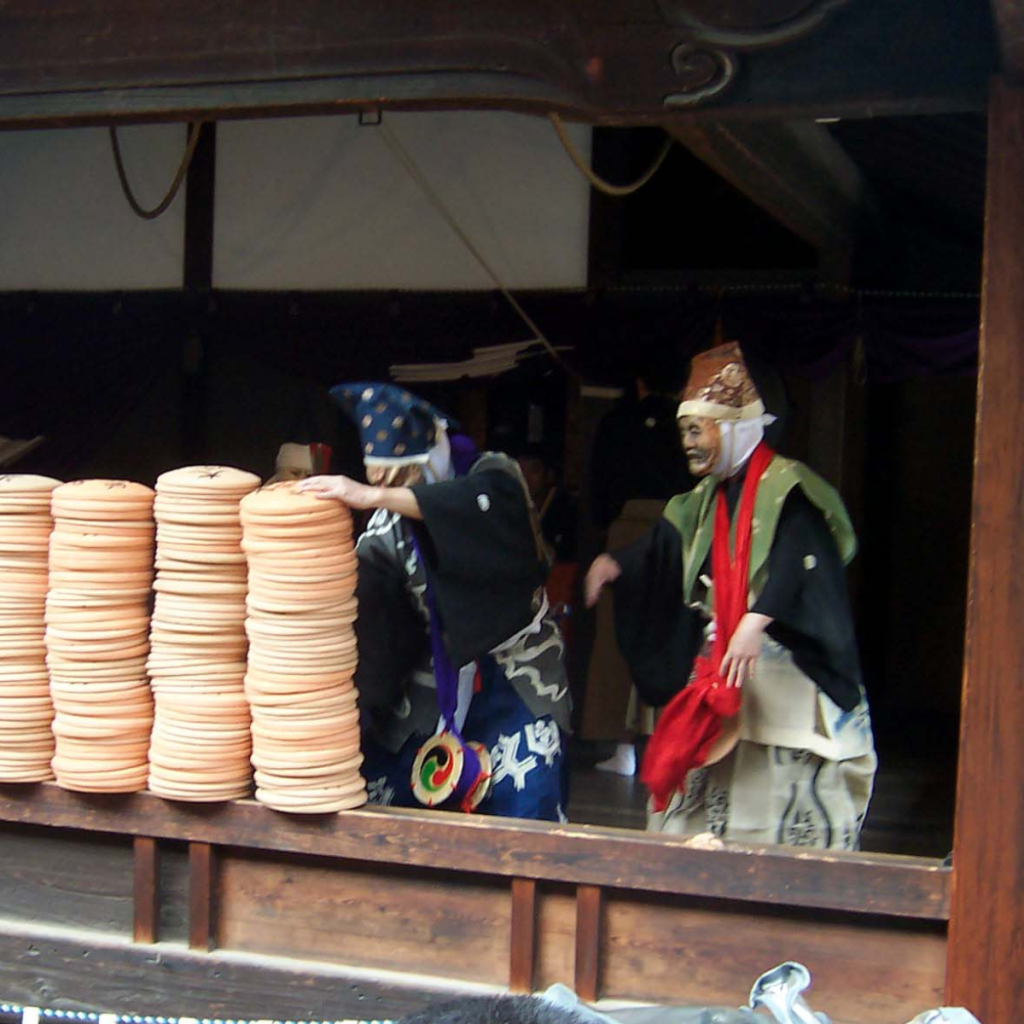
Date: April 29th to May 5th
Introduction to Mibu Kyogen
Mibu Kyogen, a centuries-old traditional performance art form, has been attracting both local and international audiences for over 700 years. Performed at the iconic Mibu-dera Temple in Kyoto Japan, these religious pantomimes have become an important intangible folk cultural asset, designated so in 1976. Highly respected for their vivid storytelling and moral teachings derived from Buddhism, they continue to entertain and enlighten their audiences.
History and Origin of Mibu Kyogen
Originating in the 1300s, Mibu Kyogen was developed under the guidance of Saint Engaku to effectively impart Buddhist morality tales to large crowds during the Dainenbutsu-e ritual. Unlike other forms of Kyogen that emerged as shorter and more comedic versions of Noh plays for samurai entertainment, Mibu Kyogen used pantomime and religious chanting to ensure everyone could understand the performances without straining to hear spoken words on stage.
Over time, these performances evolved into silent plays with period costumes, character masks, accompanied by only bells, flutes, and drums. These plays depict vignettes from Buddhist parables and Japanese folk tales even today.
Performance Schedule at Mibu-dera Temple
Mibu Kyogen performances currently take place during Setsubun (early February), spring (April-May), and autumn (October). While the February Setsubun-themed play is free to watch, visitors can enjoy five fifty-minute-long plays during April-May and October for a small fee of 1,000 yen. These plays are carefully selected from the temple’s repertoire of approximately thirty performances.
Notable Plays and Interactive Elements
Some particularly memorable Mibu Kyogen plays include creative stage interactions such as the spider demon’s thread explosion in “Tsuchi Kumo” (A Spider), the Nue demon’s tightrope act, and the breaking of unglazed plates for good fortune.
One iconic play of Mibu Kyogen is “Oketori,” telling a complicated tale of love, jealousy, and spiritual devotion. Another popular performance, called “Atagomairi,” invites audience participation by encouraging viewers to catch rice crackers thrown as protective charms during the performance.
Preservation of Mibu Kyogen Tradition
Remarkably, this unique traditional art form has been performed without interruption for over 700 years, reflecting both the devotion to the craft and the commanding presence it has within Japanese culture. The revival of autumn performances in 1974 helped to further develop Mibu Kyogen and train its successors.
Visiting Mibu-dera Temple to witness these captivating Mibu Kyogen performances is an enriching experience like no other, offering invaluable insights into the history, culture, and spiritual essence of Japan.
Yabusame Shinji
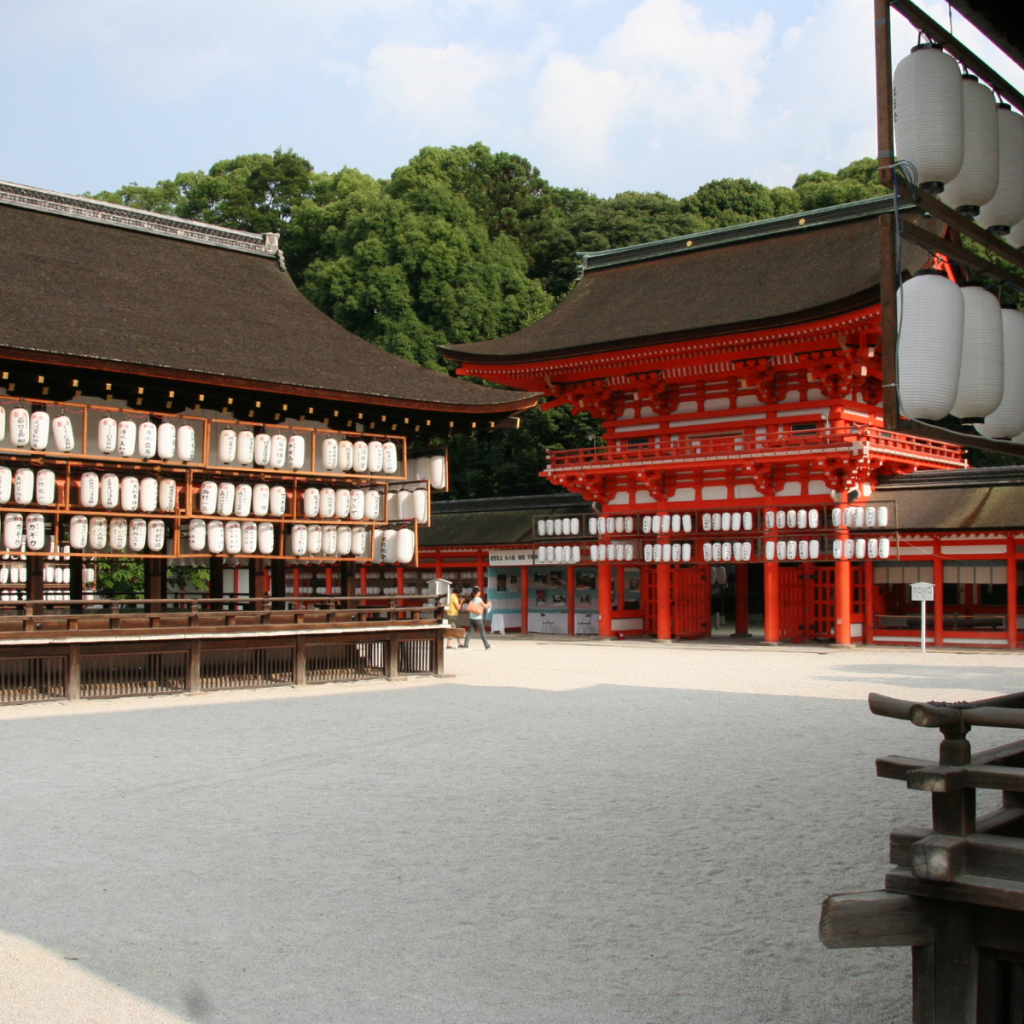
Date: May 3rd
The Aoi Matsuri Festival and Its Significance
Kyoto buzzes with excitement every year in May as the Aoi Matsuri (Hollyhock Festival), one of the city’s three biggest festivals, draws near. Centered on the Kamo Shrines (Shimogamo Shrine and Kamigamo Shrine), the festivities range from sedate purification rituals to exciting horse races. Though the festival procession falls on May 15th, various ceremonial preparations begin to take place from the first week of May, drawing thousands of visitors and worshipers from around Japan and abroad.
Shimogamo Shrine: The Historical Venue
Shimogamo Shrine, a World Heritage Site chosen by UNESCO, plays a significant role in the Aoi Matsuri festival. Surrounded by trees emitting fresh air to its surroundings, visitors feel relaxed and rejuvenated as they explore this ancient shrine, which boasts a history extending at least two thousand years – making it one of the oldest in Japan.
Yabusame Shinji: The Mounted Archery Ritual
On May 3rd at Shimogamo Shrine, one of these preparatory events commences at 13:00 within the green canopy of the Tadasu no Mori forest. The Yabusame Shinji (Mounted Archery Ritual) is held annually as part of Aoi Matsuri, with archers donning traditional Heian period court noble costumes. This dynamic ritual prays for the safety of the procession and purifies the parade route.
Performed by skilled archers from the Ogasawara school, which has a history of about 850 years, riders thunder down a 500-meter lane while firing arrows at three targets along the way. As each mounted samurai warrior races toward their targets at blistering speeds, their arrows uniquely feature a kabura whistle attached to the top, adding to the excitement.
The sound of thundering hoof-beats growing closer and closer lets people know that something thrilling is about to happen. Each time an archer successfully hits a target, a cheer can be heard from the assembled crowd, marking a moment of good luck. This celebration of traditional Japanese culture allows tourists and locals to witness a part of Japan’s rich history.
Tips for Enjoying the Yabusame Shinji Event
Due to the horses’ rapid speed and the captivating action happening throughout the event, it is recommended that visitors take videos instead of still photos. This will enable you to capture the true essence of the experience and share it with family and friends back home.
A Unique Experience Rich in Japanese Tradition
If you find yourself in Kyoto during Golden Week or are making plans to attend the Aoi Matsuri festival, be sure not to miss the Yabusame Shinji event at Shimogamo Shrine on May 3rd. This dynamic display of martial prowess and ancient sacred ritual is an opportunity to immerse oneself in traditional Japanese culture and witness this unique spectacle that continues to captivate audiences every year.
Aoi Matsuri Festival
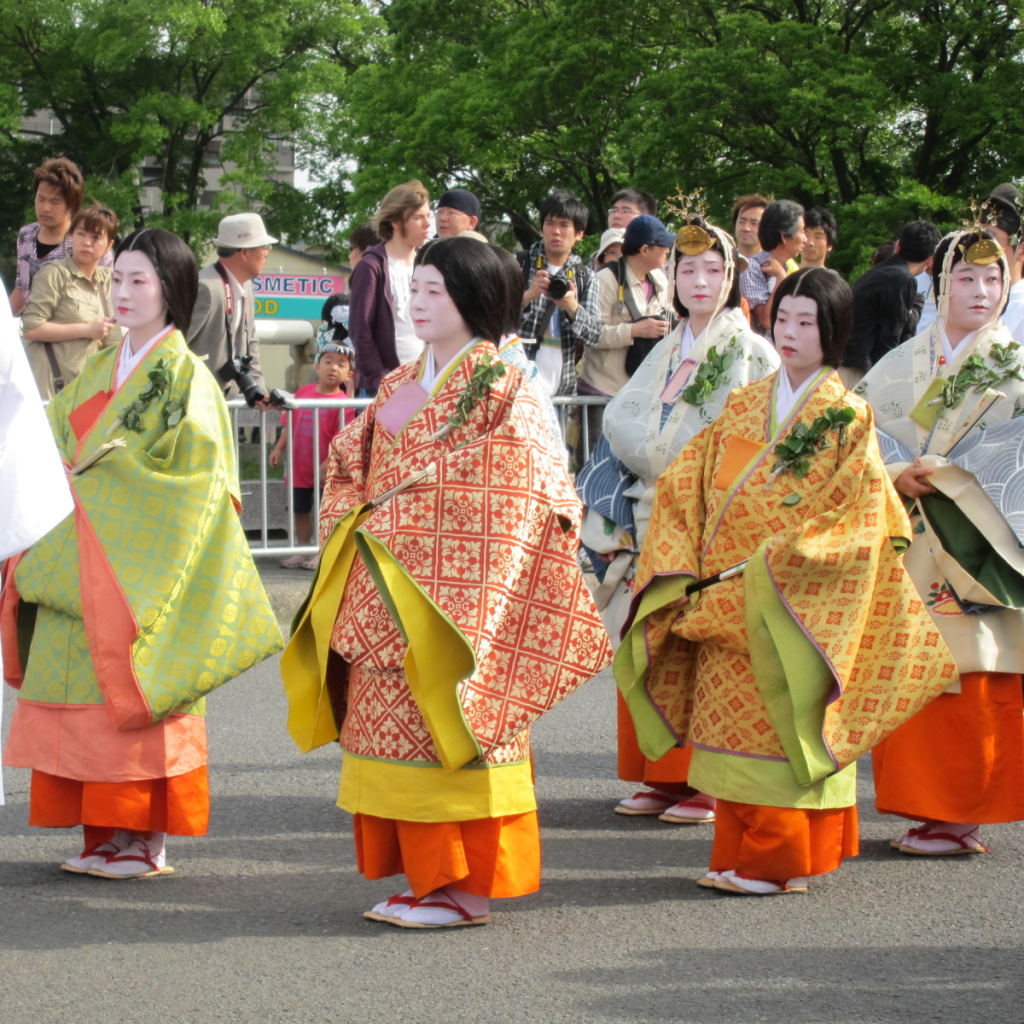
Date: May 15th
History and Significance of the Festival
The Aoi Matsuri, one of the oldest and most celebrated festivals in Kyoto, takes place on May 15th each year. It is named after the hollyhock leaves worn by the parade participants and is one of Kyoto’s three most famous festivals, alongside the Gion Matsuri and Jidai Matsuri. The word “Matsuri” originally referred only to the Aoi festival, reflecting its historical significance.
The Aoi Matsuri dates back to the 7th century, predating Kyoto’s establishment as the national capital in 794. The festival has its origins in natural disasters believed to be caused by the Kamo Shrines’ deities. After Emperor made offerings to these gods, it’s said that the disasters subsided, thus beginning this annual tradition.
Two key shrines involved in the festival are Shimogamo Shrine and Kamigamo Shrine, both directly related to the deified imperial family. Over time, Aoi Matsuri has grown in prominence, illustrating its importance in Japanese culture.
The Parade: A Showcasing of Heian Period Court Regalia
A grand procession is at the heart of Aoi Matsuri and features over 500 people dressed in traditional Heian period (794-1185) court regalia. The parade begins at 10:30 a.m. at Kyoto’s Imperial Palace and passes through Shimogamo Shrine before reaching its destination at Kamigamo Shrine.
Participants include men on horseback carrying giant bouquets of flowers, ornately decorated ox-drawn carts, and an all-women procession called “Nyonin-retsu.” This exclusively female group wears traditional court dresses and makeup, accompanied by men holding “Furyugasa,” umbrellas adorned with various flower decorations.
The Saio-dai: The Living Heian Princess
The heroine of Aoi Matsuri, the Saio-dai, was added to the procession in 1956. As an unmarried female citizen of Kyoto, she represents modern-day and historical Heian princesses who once served as shrine maidens at Kamigamo Shrine. The contemporary Saio-dai is selected each year, going through a series of purification ceremonies before leading the parade on a palanquin.
Imperial Bullock Carriage: Showcasing Royal Transportation
An unmissable part of the Aoi Matsuri comes in the form of an enormous bull pulling a carriage. This mode of transportation was historically reserved for imperial envoys and court nobles; hence its lavish appearance with beautiful wisteria flower decorations adorning it throughout the parade.
Watching and Enjoying the Aoi Matsuri Festival
For spectators looking to fully experience Aoi Matsuri, paid seating at the Imperial Palace or Shimagamo Shrine provides an authentic setting reminiscent of its historical origins. However, those willing to stand or arrive early can also view the parade along its route for free.
Leading up to May 15th, various related events take place at both Shimagamo Shrine and Kamigamo Shrine, such as horse races and purification ceremonies for the Saio-dai. These events provide opportunities not only to enjoy traditional Japanese celebrations but also journey back in time to experience old Kyoto’s aristocratic splendor.
Mifune Festival

Date: Third Sunday of May, every year
On the third Sunday in May, Kyoto’s Arashiyama district comes to life as it hosts the Mifune Matsuri (Three Boats Festival) at Kurumazaki Jinja Shrine. The festival attracts up to 100,000 tourists each year and showcases a unique experience inspired by elegant Heian period boating parties attended by the Emperor and his court.
A Journey Back in Time: The Heian Court Ladies and Shirabyōshi Dancers
Leading the festival is a procession of priests from Kurumazaki Shrine, a location well-known for worshipping gods of artistic talent. Accompanying them is a woman dressed as the famous writer Sei Shonagon, author of The Pillow Book.
In addition to elegantly dressed Heian court ladies and their attendants, shirabyōshi dancers from the Japanese Imayō Song & Dance Association (Nihon Imayō Utabugaku Kai), musicians from the Ichihime Gagaku Association (Ichihime Gagaku Kai), and honoured guests participate in the parade that starts from Nakanoshima Park and crosses the popular Togetsukyō Bridge.
Artistic Performances on Traditional Boats
Mifune Matsuri is best known for its breathtaking demonstrations on water. Taking place at scenic Oi River near Togetsukyō Bridge, participants board traditional boats adorned with bird or dragon heads. The boats include three celebrated styles: Gozabune – a boat for carrying nobles, Ryutosen – a dragon-head boat, and Gekishufune – a waterfowl neck boat.
Distinct from other Japanese festivals, Mifune Matsuri does not have a boisterous atmosphere but instead captivates audiences through the refined display of “three arts”: Japanese poetry (waka), Chinese poetry (kanshi), and musical performance and dance (sōgaku).
The Connection to Kurumazaki Shrine, the Patron of Performing Arts
The modern Mifune Festival dates back to 1928, organized by Kurumazaki-jinja Shrine. Standing close to the river, the shrine serves as a haven for performing arts and is visited by famous stars who pray for better stage performances and increased popularity. It is also frequented by members of Kyoto’s geiko (geisha) community.
A May Celebration Capturing Japan’s Rich History
As an opportunity to experience Japan’s vibrant history and appreciate its traditional arts, Mifune Matsuri offers an enthralling display that delights both locals and tourists alike. Commencing with a ritual held at Kurumazaki Shrine at noon, visitors can watch period-costumed participants proceed along Arashiyama’s Togetsukyo Bridge and float sensu fans in assorted colours before boarding the boats.
So if you find yourself near Kyoto in mid-May, be sure not to miss this incredible celebration at the Oi River near Togetsukyō Bridge – a once-in-a-lifetime chance to step back into Japan’s past and appreciate artistic performances like no other.
Kamogawa Odori
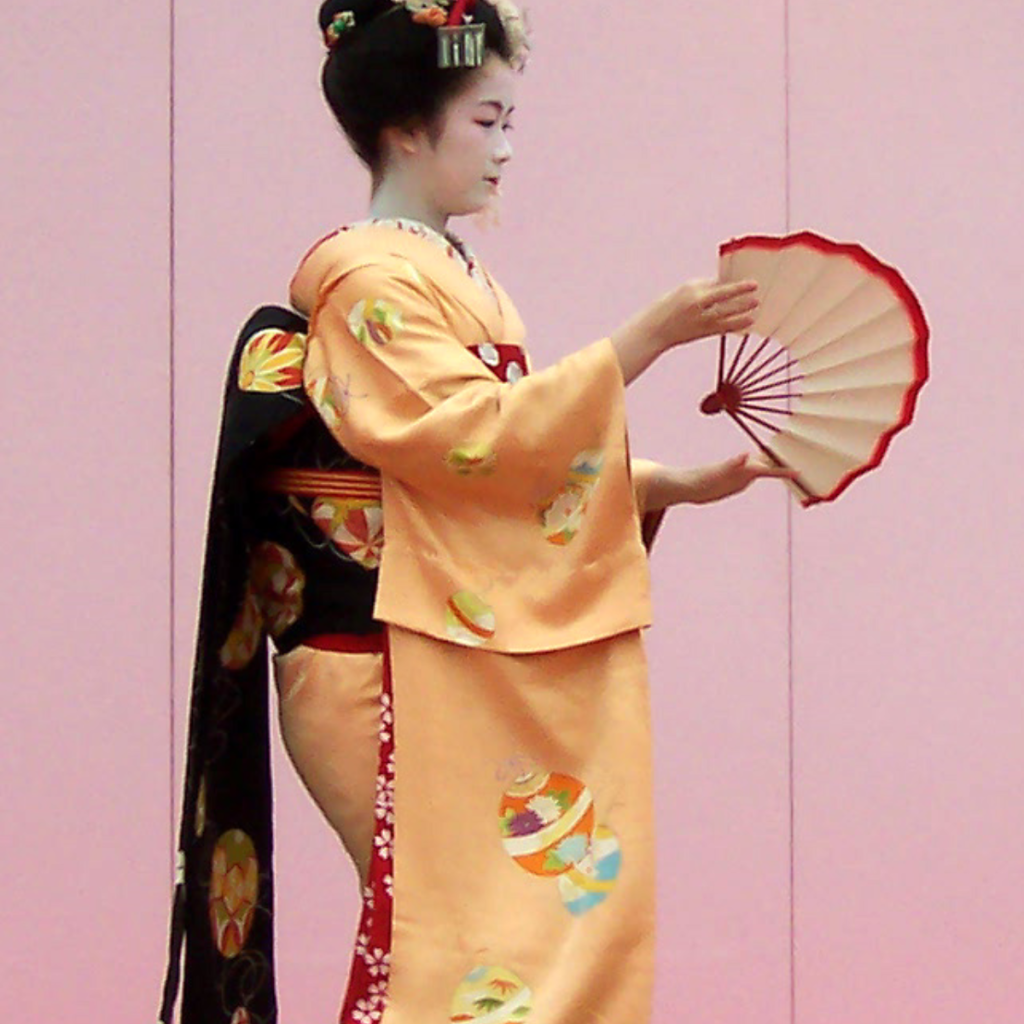
Date: May 1st to May 24th
The Kamogawa Odori remains a timeless testament to Kyoto’s rich cultural heritage – a must-see event for those keen on experiencing an authentic blend of traditional Japanese arts and contemporary flair.
The Last of Kyoto’s Spring Geisha Dances
The Kamogawa Odori, an annual event held in May, is the last of Kyoto’s traditional spring geisha dances. The enchanting performance showcases the talents of geiko (the Kyoto term for geisha) and maiko (apprentice geisha) from Pontochō. Initially introduced during the first Kyoto World Fair in 1872, the event has since continued to captivate local and international audiences.
Pontochō Kaburenjō Theatre: The Dance’s Historic Stage
The annually-held performance takes place at Pontochō Kaburenjō, a theater specially constructed for this purpose. Completed in 1927, the theatre has provided a venue for geiko and maiko dancers to showcase their skills and entertain audiences from all around the world.
A Glimpse into the World of Geishas
Every spring and fall, public dance performances are held in Kyoto’s hanamachi (geisha districts), offering an opportunity to witness the city’s iconic performing artists at a relatively affordable price. Attending these shows is considered a more polite means to appreciate geishas than attempting to photograph them on the streets paparazzi-style.
Kamogawa Odori: A Journey through its Rich History
- 1872: Kamogawa Odori was established by the Pontocho Kabukai Association.
- Meiji Era & World War II: The dance witnessed intermittent cancellations but was soon resumed after the war ended.
- 1951 – 1998: The event was held twice a year; once in spring and once in autumn. With over 184 performances currently recorded (as of 2023), it now boasts the highest number among the five Kyoto Hanamachi districts.
- Present: The event is now held annually in spring. Geisha and maiko dancers continue to entertain audiences with their captivating two-part performance of dance drama (part 1) and pure dance (part 2).
A Global Phenomenon Attracting Renowned Celebrities
Kamogawa Odori’s unique charm has garnered international acclaim, attracting noteworthy overseas celebrities such as Jean Cocteau and Charlie Chaplin who were enchanted by the elegant dances.
A Blend of Tradition and Modernity
During the early Showa Era, the Kamogawa Odori began seeking ways to balance tradition and modernity. They incorporated Western music and young girl revues in a bid to stay relevant and evolve with the times while still preserving the beloved elements of their esteemed custom.
Wisteria
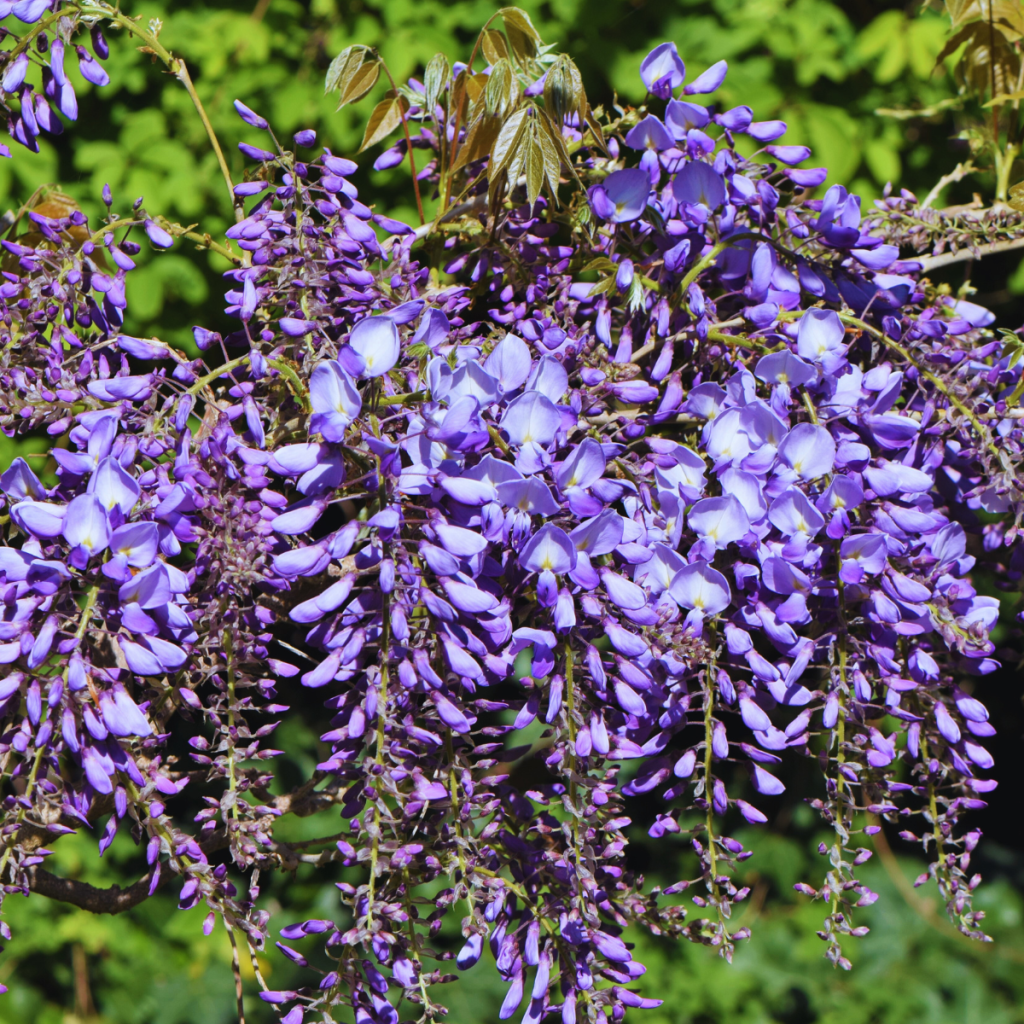
Date: Early May -Mid May
The Beauty of Wisteria in Kyoto
Wisteria, known as “fuji” in Japanese, is a popular ornamental vine adorning many gardens and temples throughout Kyoto. These climbing vines are carefully cultivated to grow on trellises, creating stunning tunnels and canopies that offer some of the most enchanting strolls imaginable. Often seen in purple, wisteria flowers can also be found in white, pink, and violet shades. The dangling clusters sway gracefully in gentle spring breezes, creating a fragrant and picturesque setting for relaxation.
Unexpected Wisteria Destinations
Surprisingly, one of the most popular places to view wisteria in Kyoto is the Toba Water Treatment Plant. This location is open to the public during the spring season, allowing visitors to stroll beneath the plant’s 120-meter-long wisteria trellis. Traditional religious sites such as Byōdō-in temple in Uji City, Saiin Kasuga Jinja shrine in central Kyoto, and Sentō Gosho on Imperial Palace grounds also boast incredible displays of wisteria alongside their rich cultural history.
Ancient Wisteria at Byodoin Temple
In addition to being a UNESCO World Heritage Site, Byodoin Temple is renowned for its breathtaking wisteria displays. Situated along the Uji River within Kyoto Prefecture, the temple features multiple trellises containing 280-year-old wisteria vines. Some clusters have grown more than three feet in length, creating mesmerizing cascading purple waterfalls.
A Fragrant Tunnel at Kamitoba Sewage Treatment Plant
By opening its doors to the public each spring, Kamitoba Sewage Treatment Plant has become an unexpected hotspot for wisteria admirers. Featuring a 120-meter-long tunnel draped with blooming wisteria flowers, the plant continues to attract an increasing number of visitors eager to experience the wonder firsthand.
The Zen Gardens of Taizo-in Temple
At Taizo-in Temple, the oldest of Myoshin-ji’s 46 associated temples, wisteria blooms can be enjoyed in April and May amid a tranquil Zen garden setting. The pond-side trellis, adorned with swaying wisteria blossoms, adds another dimension of beauty to the serene landscape. As it’s a lesser-known destination on the outskirts of Kyoto, Taizo-in offers an opportunity for peaceful strolls away from tourist crowds.
Unique Experiences at Taizo-in Temple
The gourd-shaped garden pond once housed namazu catfish but is now home to vibrant koi fish, swimming freely amid a well-manicured landscape. To enter the garden area, visitors can step across an enormous rock embedded into the ground while admiring a beautiful sakura cherry tree nearby. In addition to wisteria viewing, travelers can participate in a unique experience: pouring water onto a small rock waterfall accompanied by the soothing sound of cascading water echoing through the serene space.
While wisteria may not be as famous as its floral counterparts like cherry blossoms or maples leaves, these enchanting blooms have undeniably captured the hearts and imaginations of those who visit Kyoto during springtime, transforming gardens and historic sites alike into extraordinary wonderlands.
Iris Bloom Season
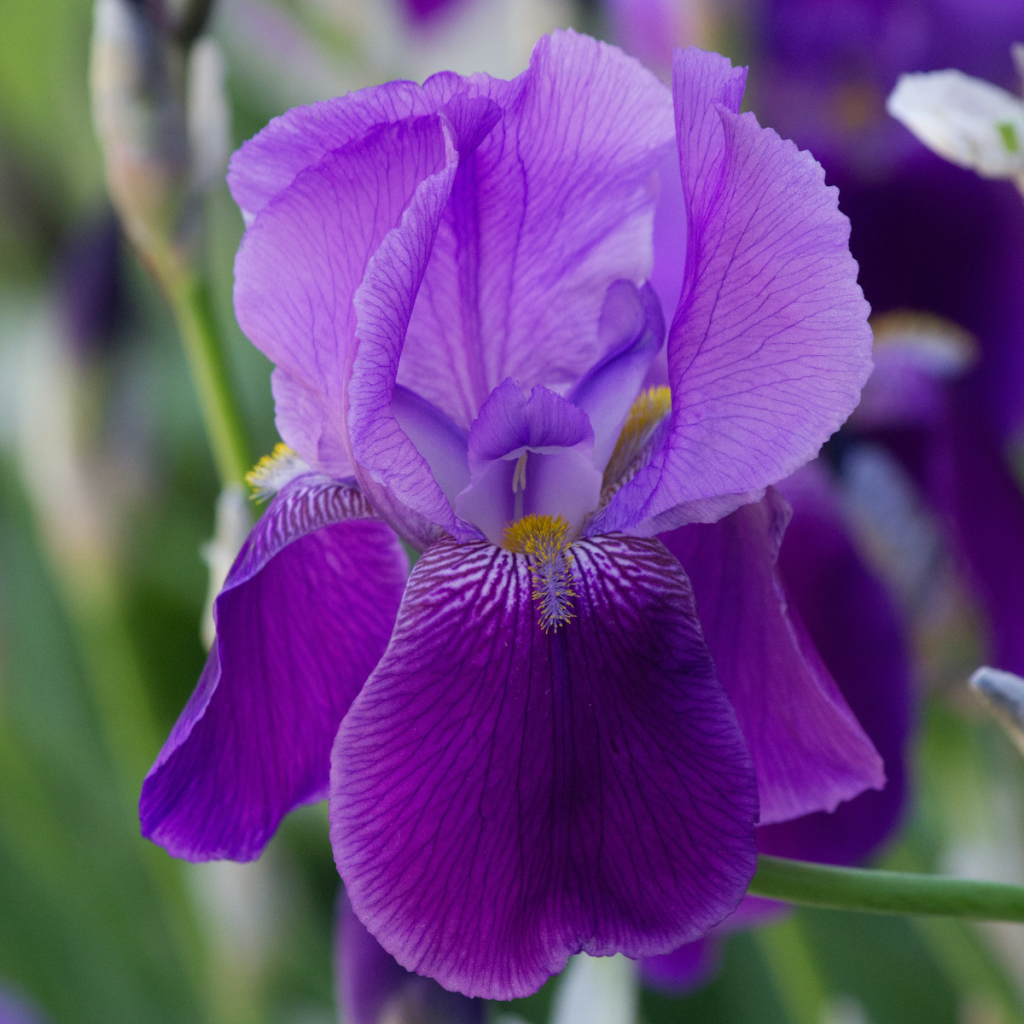
Date: May 1st – 31st
During the iris bloom season, Kyoto transforms into a colorful paradise adorned with a spectacular display of the elegant flower. Preserving their presence in Japanese culture for centuries, these striking blooms continue to embellish the traditional gardens of Kyoto, attracting numerous admirers seeking a glimpse of their exquisiteness. With a host of renowned sightseeing spots offering exceptional views of irises in all their splendor, Kyoto remains an unmissable destination during this vibrant season.
A Spectacle of Iris Flowers Blooming in Kyoto
Every year in May and June, the historic city of Kyoto is adorned by an enchanting display of iris flowers. These stunning blooms can be found in various shades, such as purple, blue, white, and yellow, spread across gardens and ponds throughout the city. As a prominent part of traditional Japanese art and literature for over a thousand years, the elegant iris has been carefully cultivated to preserve the authentic garden aesthetics that have attracted visitors from far and wide.
Three distinct varieties of Japanese irises attract attention from both locals and tourists alike: kakitsubata (iris laevigata, “rabbit-ear iris”), hana shōbu (iris ensata, “Japanese water iris”), and ayame (iris sanguinea, “blood iris”). Each variety features unique colors and shapes, allowing discerning onlookers to pick out their favorites.
Top Iris Viewing Spots in Kyoto
Kyoto offers multiple picturesque locations where one can enjoy the captivating sight of irises in full bloom. Among them are Heian Jingū, Ota Shrine – a National Natural Monument, Kajū-ji Temple famous for birdwatching, Umenomiya Taisha Shrine positioned towards the west of the ancient capital, Kyoto Imperial Palace Park, Nagaoka Tenmangū – renowned for its azaleas, and Kyoto Botanical Gardens.
Ohta Shrine’s Historic Iris Garden
The Ohta (Ota-Jinja) Shrine Iris Garden presents a stunning sight for visitors. As an esteemed national treasure, it famously draws crowds during early May when the irises are in full bloom.
Kamo Kurabeuma
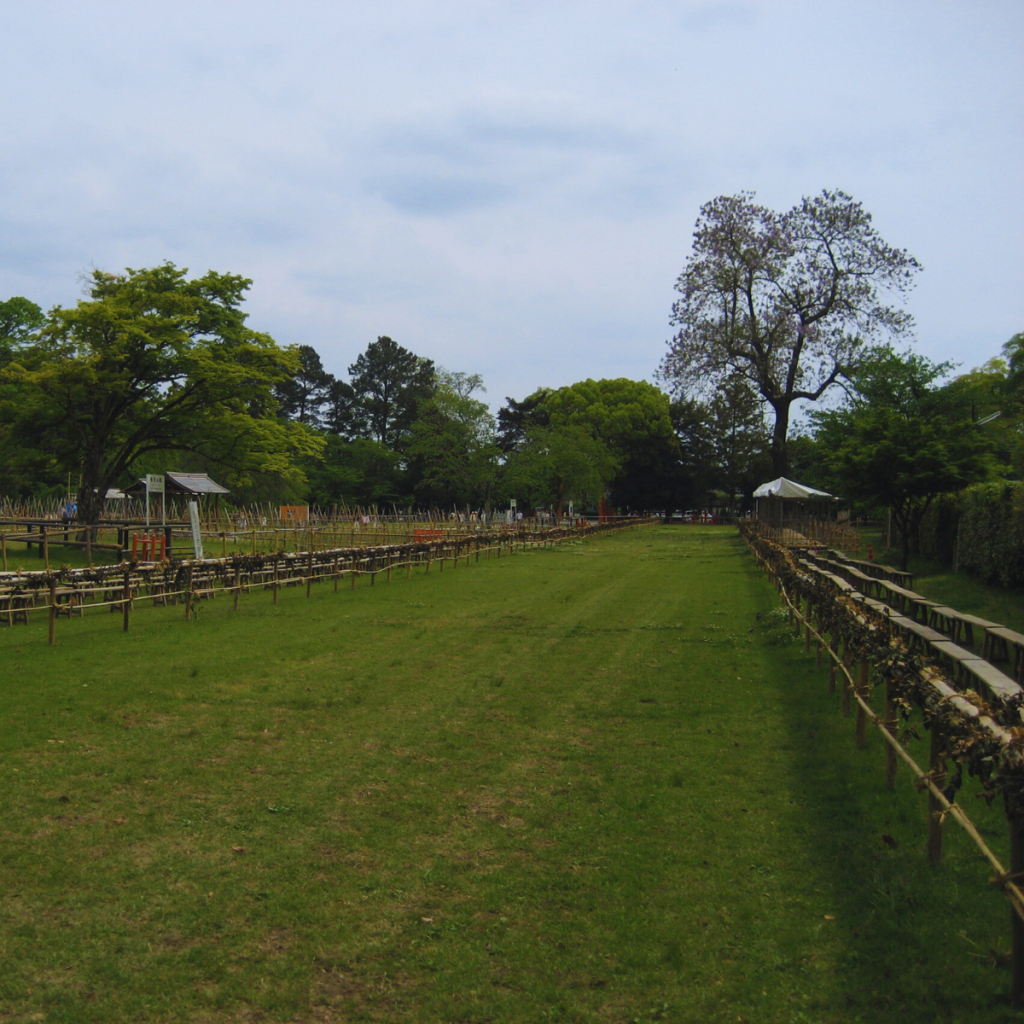
Date: May 5th
A Brief Historical Outlook
The annual horse race held at Kyoto’s Kamigamo Jinja, known as the Kamo Kurabeuma takes place on the fifth day of the fifth month, serving as a prelude to the grand Kamo Festival (commonly referred to as the Aoi Festival). Celebrated since the Heian period, this event has persisted through over a millennium.
This ritual event traces its origins back to 1093 when Emperor Horikawa (1079–1107) presented a horse race, usually conducted at the Kyoto Imperial Palace, to the deity of Kamigamo Jinja. The festival has continued non-stop at this shrine ever since then. This event has gained considerable recognition due to its history and religious significance and is now registered as an Intangible Folk Cultural Property of Kyoto.
Preparation Rituals Mark Start of Event
On the day of Kamo Kurabeuma, preparation rituals are performed diligently. A specialized race track stretching over 200-meters is set up on the left side of the path lying between the first and second torii gates of Kamigamo Jinja. The deity Kamo Wakeikazuchi no Okami, towards whom this race serves as an offering, is shifted to a temporary enshrinement site beside the track.
Several rites are then performed aimed at purifying participants and praying for nationwide peace, good harvest, and safe culmination of this event. Ritual practices such as drinking ceremonial sake, offering sacred sakaki branches, and riding horses in both sun and moon configurations reflecting yin-yang philosophy from ancient times associated with Kamigamo Jinja are fundamental components.